Whether you’re a new person in the affiliate industry or you’ve been working a while in this area you probably heard about the importance of landing pages and load speed.
That’s why most affiliates recommend to get started with a VPS and later move to a dedicated server or CDN + dedicated if you want to handle a lot of visits per day.
A huge problem though is that as an affiliate you need to learn a very wide range of skill sets going from coding, to servers, to offers and traffic and even networking and the importance of relationships. because of that, the servers are relegated to the bottom of our priorities and later we learn the importance of them.
How many times have you heard:
Can I use my Hostgator/GoDaddy shared account? I just want to get started and do some tests.
On top of that, they use WordPress for a simple landing page with a call to action, an image, and a headline.
And the first thing we usually answer is:
Hell no, get out of that shared service and get a proper VPS or you’ll lose money and conversions.
A good landing page that could be loaded in 100 mili-seconds could take 2-5 seconds in a shared host without proper optimization. And that means a ton of people are not going to see your landing page before they close it, especially if your traffic comes from sources like push notifications, pops or redirects where the targeting is very generic, but also applies to higher quality traffic sources in a lower percentage.
At the same time, people who want to get started (or even if you’re already making money but want to scale) have the problem of not wanting to pay hundreds of dollars for their servers. A managed VPS from any known company starts at $25-$30 per month with the basic plan, and can easily go to $100 per month with an “advanced” plan with 4 cores and 8GB of RAM.
After that, you find the dedicated servers that easily start at $100-200 and can go up to $500-1,000 according to the specs.
That’s half of the monthly budget for campaigns for a lot of people (hence, they want to spend $5-10 with a shared service). But it doesn’t have to be like that.
You can get the performance of a dedicated server starting at $2.5 per month if you use an unmanaged service like Vultr or DigitalOcean and pay as you go (hourly rates) while having very good performance (a good VPS for $20 can outperform a managed dedicated server that costs $150 per month) and multiple locations available around the world without monthly or annual contracts to pay.
Managed vs. Unmanaged server
If you have no idea what’s the difference between managed and unmanaged servers you’re probably using a managed service.
Managed Servers
It’s easy to recognize them because their plans have cPanel or WHM to handle all your websites and you can contact their support when something goes down or you want to do a migration and they will do it for you (sometimes at an extra price).
Launching new websites is easy cause you just need to add a new account and select software like WordPress and it will do the installation automatically. If you’re totally new and have no idea how to upload a landing page or what’s HTML then a managed service has its pros.
I used a managed VPS for the first months while learning paid traffic back in 2014 and I thought it was good, but when my campaigns started to go big I had to scale more and realized a managed service was not going to cut it unless I paid a lot and even then, I was leaving money and conversions in the table.
Unless you’re using a self-hosted tracker, you’re only slapping landing pages with JS/HTML/CSS (sometimes PHP) in your server and loading them as fast as possible.
That’s it.
A managed service doesn’t really help much and you don’t really use all the extra layers and services like email hosting (pretty bad BTW), installer for other CMSes like WordPress, Joomla, etc. but you’re still paying for them. A cPanel license costs $20 per month so if your VPS costs $30 you’re actually getting the specs of a $10 VPS or less since many of them are being resold from other companies.
The cons of using a managed service are:
- Lower specs as you’re paying for tech support, licenses, etc on top of the raw hardware
- Pricing (VPS starting at $30 per month or higher) and you have to commit to a monthly/quarterly or annual plan, but you know campaigns can be paused any day without promises of coming back.
- Locations: only available on the US for most companies or some places in Europe but you’re limited to that location for all your sites.
- Scaling and usage: if you want to scale, you need to hire a new, more expensive plan. If you use your server for 7 days out of a month, you will pay the whole month as you already paid upfront.
Overall you’re paying for support and a pretty interface easy to handle with the hundreds of tutorials available around the web for WHM/cPanel. This can be good enough for websites using WordPress or other services but developers tend to prefer unmanaged services because they can do whatever they want with their hardware and pay as little as $5 per month with the performance of a $150 dedicated server.
Unmanaged Servers
If you choose to use an unmanaged service, you’ll not have support. You’re pretty much on your own.
If your site goes down, or the memory leaks or the database crashes, you’re on your own and you need to fix it up.
But for us (affiliates) who mostly want to upload landing pages and we have several domains, IPs, etc. an unmanaged service can be more efficient and at the same time you might be paying less than with the managed server. You can do whatever you want with your OS installation, apps, hardware, etc. and you can deploy a virtual machine in a couple of minutes with great performance and no issues whatsoever.
On top of that, you can add a simple intermediary by using a managed panel that focuses on performance and takes care of things like SSL certificates without adding a ton of other extra stuff we don’t need.
Let’s see how to do that in the following tutorial.
Enter Vultr (VPS provider)
Before you ask, I have been testing several cloud VPS services like Vultr, DigitalOcean, Linode, Amazon AWS for the last 3 years.
A well-optimized VPS in the right location can outperform a CDN or a dedicated server on most of the cases. This is something I have confirmed with a lot of my friends and running my own campaigns.
And don’t think these are unknown companies you can’t trust.
In fact, DigitalOcean is the second-largest server provider in the world just behind Amazon. So if you thought only the branded guys like GoDaddy, Bluehost, etc. were big, think again.
They just target different (general) audiences and that’s why you see GoDaddy in the super bowl ads instead of hearing of Linode (developers), for example.
In the last 3 years, I have split tested the performance and pricing/features of all the mentioned above and so far my favorites are Linode and Vultr. They’re always on top of DigitalOcean, Linode and Amazon Lightsail in terms of hardware specs and performance and their UI is as nice as DigitalOcean, which is great.
They also have more locations available than Linode and DO. Let’s see how to deploy a Vultr VPS for just $6 a month.
First, you need to create a Vultr account: CLICK HERE TO GET A $100 SIGN UP BONUS.

Just fill up your email and password and validate it as you’d do with any other service.
After your account has been validated you’ll see your Dashboard with servers and locations. You can see below that at the moment of writing this post I had 8 servers running in different locations (1 or 2 per continent) and I am being charged for each of them on an hourly basis.
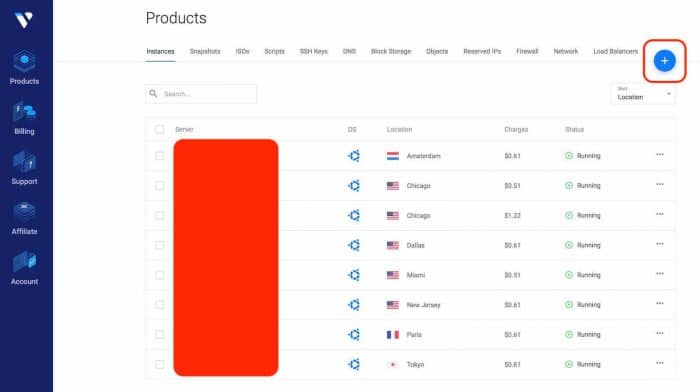
Your Dashboard will be empty, and you can start deploying a new server ASAP but before I recommend you add your payment method.
Vultr is very flexible and they take Credit Cards, Paypal and Bitcoins as well.
Now go back to your Dashboard and click the button (I marked it in red in the image above) to deploy a new instance. You can select a Cloud Compute instance, a Storage Instance (great for keeping files in the cloud similar to Dropbox), a Dedicated Instance, which is similar to getting a dedicated server or a High-Frequency instance, which is the one we’re going to use for this guide.
The high-frequency instance is my favorite as it has better hardware specs (mostly CPU and storage speed) and they outperform all of the competitors just by paying one extra dollar. Instead of costing $5 like the regular cloud compute instance this one costs $6 per month and it’s totally worth it.
Also, make sure you select the closest location to where you’re going to run your campaigns for maximum performance and minimum latency. That’s why I have several servers around the world.
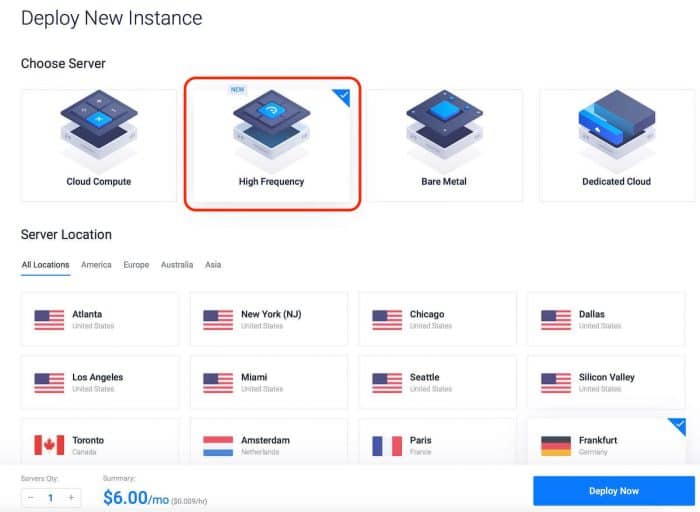
If you’re running traffic in the USA, a server in the “middle” of that country like Atlanta or Dallas might perform better than a server near the east/west coast. You also have different locations for Europe and a couple of locations for Asia and Oceania.
I wish they had a node for Africa and maybe another in India, but so far they have more than the competition. DigitalOcean has a node in India so if you’re running good volumes in India you should check that out instead.
Now you need to select your server OS or application. We’re going to select an empty OS without any server applications as we will install that later with a VPS manager.
Select Ubuntu and make sure you’re using versions 16.04 or 18.04 x64 like I’ll show in the following picture:
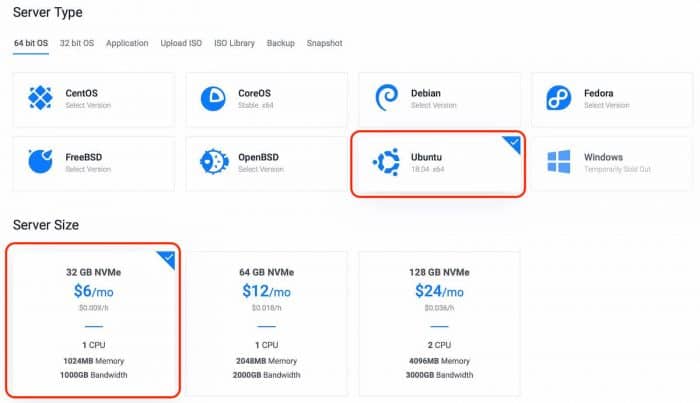
Now you need to select your server size. I choose the $6/month VPS because that should be enough for most people getting started. I have been able to receive around 1 million clicks per day in a server like that without having performance issues. You can get the $12/month server if you think you’re going to run high volumes from the very beginning or if your landing pages are heavy and you need tons of processing power.
For most affiliates, the landing pages tend to be fast and simple, but you will be able to analyze your stats later and decide if you want to upgrade to a fastest server, so don’t worry right now about this.
Create your Vultr account: CLICK HERE TO GET A $100 SIGN UP BONUS.
Perhaps the most important thing here is the bandwidth, which starts at 1,000 GB or 1 TB per month. If you’re running banner/push/native traffic this might be more than enough, but if you’re running PPV/pops and redirects you might want to keep an eye on your usage (there’s a dashboard where you can check this) to see if the server is handling things well and the bandwidth you’ve consumed through the month.
- For example, a 200Kb landing page getting 30,000 visits per day on Facebook will consume around 6GB of data per day. That’s 180GB per month which is still just 18% of the 1TB available.
- But a 100Kb landing page getting 3 million visits per day from pop traffic will consume 300GB of data per day or 9 TB per month, so you’ll need a higher plan.
Anyways, just calculate what you need or select the $6 plan and check your stats through the days to see if you need to upgrade/downgrade your plan.
Finally, just leave all the rest of the forms blank and just fill the Server Label (marked in a red box below) where you’ll put the name of your server (i.e. the name of your domain for organizational purposes) and click the “Deploy Now” button.
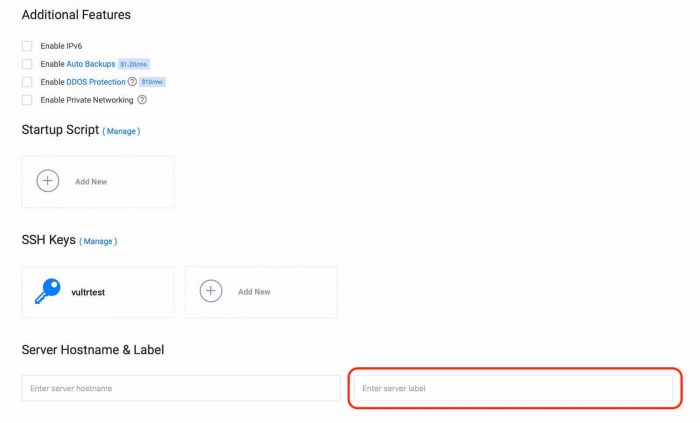
Vultr will create your server, install Ubuntu in a few minutes. You’ll get an email like the one below when it’s been done. After you get the email I have noticed Vultr still needs to finish up the installation so it’s better if you wait 5 minutes before doing anything else.
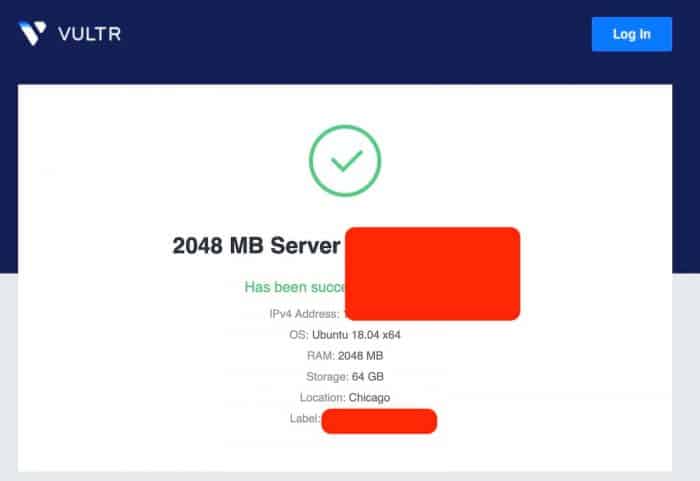
You will need the IP address from the email to set up a few things later but you have all the information for easy access in your Dashboard now. See the image below for the important data you need to write down including the username and password.
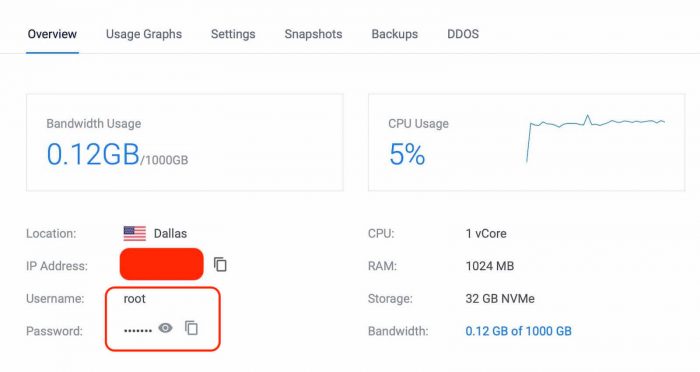
If you ever want to upgrade the server just to to the “Settings” menu inside your server’s dashboard and the “Change Plan” button on the left side. There you can choose a new plan and your server will be restarted (takes 1-2 minutes) to get the new hardware specs.
Yup, it’s that easy and you still get charged by the hour!
Setting up your DNS
Setting up the DNS is an easy process that takes 2 minutes. First, you need to go to your Domain provider (Godaddy, Namecheap, etc.) and set up custom DNS for your domain pointing to:
- ns1.vultr.com
- ns2.vultr.com
If you’re using Namecheap this is how it looks:
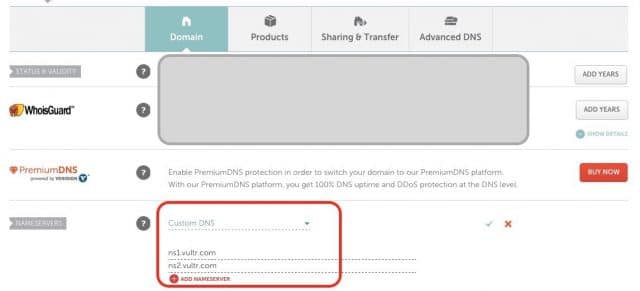
Now that your Domain provider is pointing to Vultr’s servers, you need to link your server IP with your Domain. Keep in mind the domain propagation around the world can take up to 48 hours. If you see your domain is still pointing to a parked page or another server just wait some time or clear your browser’s cache.
I prefer managing my DNS through premium DNS providers like Cloudflare (free) or DNSMadeeasy, however, I will talk about that in another article as it can get confusing.
Now go back to Vultr and in the “Servers” main menu click the “DNS” submenu and click the “Add Domain” button as marked below:
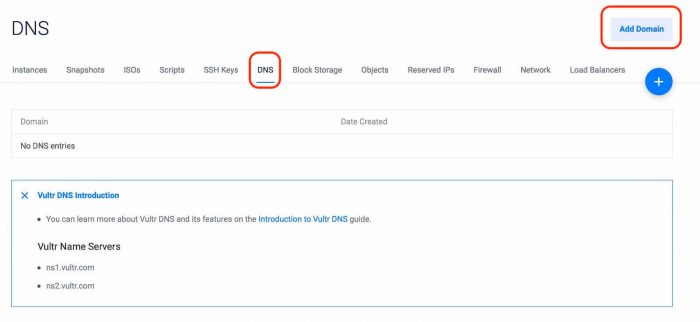
In the next step just fill out the new IP of your server (you can check it in your server’s dashboard or the email you received after launching your server) and write down the domain you’re pointing from GoDaddy/Namecheap. In my case, I just wrote down “yourlander.com” as an example.
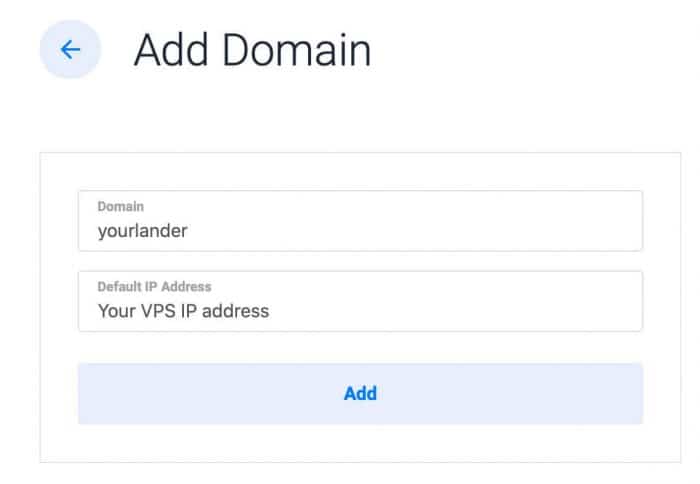
After you click the “Add” button from above, you’ll see your A/CNAME/MX/NS records and you’re good to go.
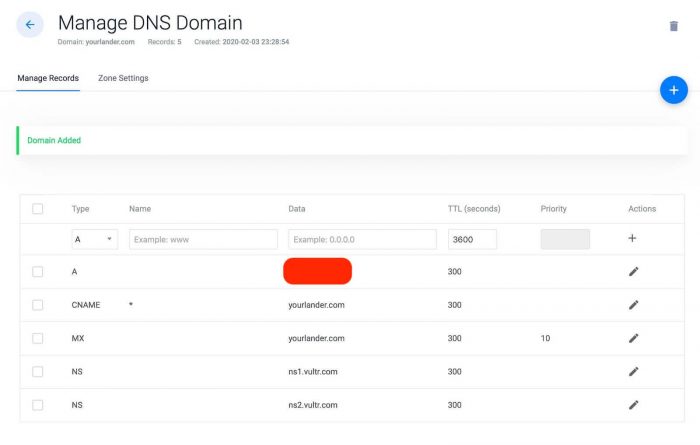
If the DNS settings have been propagated to your location you should now be able to type the domain in your browser and see an image with Vultr’s logo or some branding. At this moment even if you don’t see anything it doesn’t matter since your VPS is still empty and you need to install your server software and upload your landing pages for it to work.
Create your Vultr account: CLICK HERE TO GET A $100 SIGN UP BONUS.
Installing your stack and SSL certificate with Serverpilot
As I explained before, your server right now has a clean installation of Ubuntu (OS) and it doesn’t work to serve online pages yet.
Before I used to recommend setting up an application straight from Vultr to install a LEMP setup but the problem was that it wasn’t easy to add an SSL certificate for your domain unless you’re good and coding and have some server knowledge.
Since most affiliates focus on learning marketing skills and not coding skills we’re going to use a software that helps us install a fast server stack and also apply our SSL certificate within a few minutes.
This software is called Serverpilot and you can sign up right here.
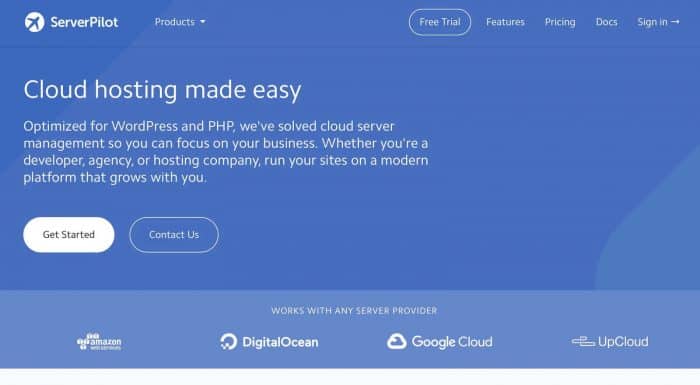
I won’t explain how to create an account on Serverpilot as the process is super easy. Make sure you confirm your email as always and add a payment method (CC or PayPal) before continuing with the procedure.
Once you have your account you will see your dashboard:
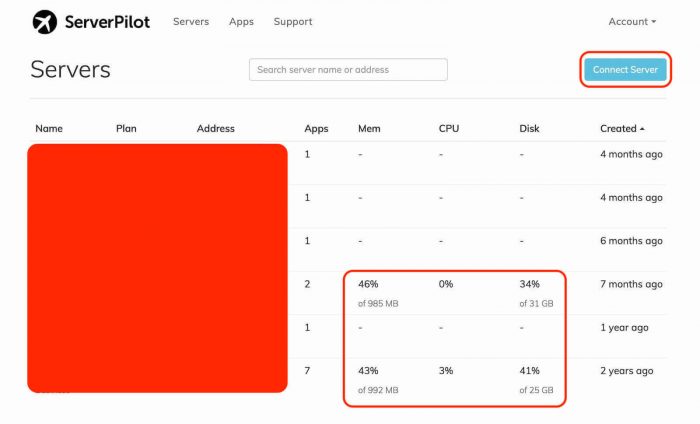
Here you can see I’m managing several servers with Serverpilot and some of them have several apps (a.k.a. domains). I can also check the CPI, Memory and disk usage of some servers as I need it.
Your dashboard will be empty and first, you will need to connect your Vultr server with Serverpilot. Click the connect server button at the top right side and you’ll see the following screen:
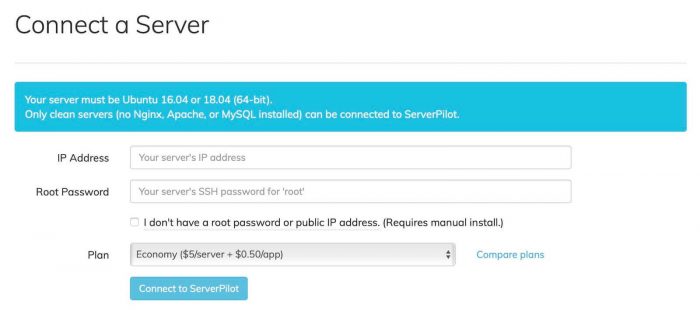
Here, you will need to input your server IP address and root password, which you can find in your Vultr account as I showed you before. That’s why I said it was important to write those down but you can always go back to your VPS settings and check them again.
After that, select the Economy plan or the business plan if you want to see the stats like CPU/Mem/disk usage right in your Serverpilot account. Those stats will be useful once you start running a good amount of traffic. Otherwise, just stick to the Economy plan.
Once you connect to Serverpilot you will see a progress bar where Serverpilot prepares everything you need including installing PHP, your NGINX server, swap memory, etc. This process takes around 5 minutes so go grab a coffee and come back later.
Once the process is done, Serverpilot will be connected to your VPS and it will ask you to create your first app.
Apps on Serverpilot are like websites or domains, so for each domain you want to use to upload landing pages, you should create an app.
Each app costs $0.5 to create while the server connection costs $5 in the Economy plan. So if you have 1 server with 4 domains you will end up paying $7 to Serverpilot. You can always delete or add new servers and apps and they will be charged by the hour, just as Vultr does.
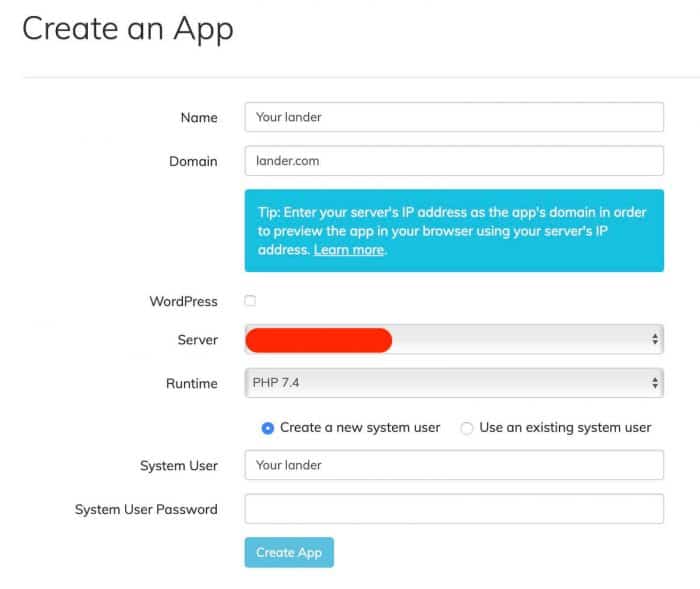
Creating an app is simple. You just need to fill the following forms:
- Name: The name of the app to be shown on Serverpilot. e.g. landingpages
- Domain: The domain you’re going to set up with your server. This is the same domain you pointed to Vultr’s DNS before. e.g. landingapges.com
- WordPress. Leave this unchecked as you want to upload your own landing pages and not create a WordPress site.
- Server: select the server you just connected from this list.
- Runtime: PHP version. If you’re using static files (HTML/CSS) this doesn’t matter, however, if you plan to use PHP in your landing pages you should use one of the latest versions like PHP 7.2 or PHP 7.3 at least as that’s what most people use nowadays for maximum performance.
- System user: since it’s the first time you’re setting up an app on Serverpilot you can create a user and password to have access to this app directly. Or you can still use your root user and password from Vultr and have access to all of the apps in your server as I’ll explain below.
Hit that “create app” button and Serverpilot will take a few seconds to create your new app.
Once this process is done, you’ll have a fast server ready to run and handle a ton of visits per day and you can access by typing the domain into your browser.
However, the server is still empty and you need to upload your landing pages.
But before that, we are going to enable your SSL.
Why?
Well, most of the internet has already moved to SSL connections in the last few years. There are traffic sources that won’t accept your campaigns and landers if the SSL certificate is not installed and Chrome is updating their browser to show an alert message when the connection is not secure, so using an SSL certificate nowadays is a must in my opinion.
Also, it seems like cookies won’t work soon if you don’t use an SSL connection so you definitely want to do this. I’ve been using SSL certificates without problems for over 3 years and I still find some offers or affiliate landers without SSL.
Once you create your app, this menu will be shown:
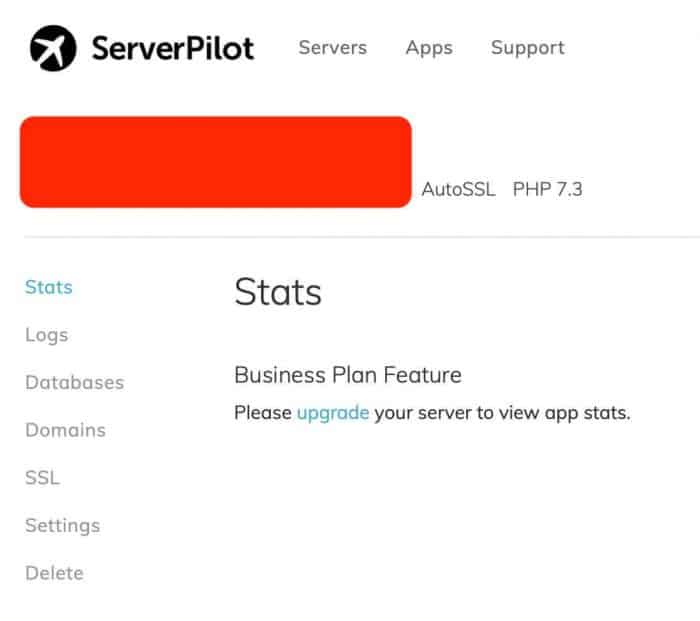
If you’re using the Economy plan, you won’t be able to see any stats but once you run some volume make sure you upgrade your plan so you can check the stats of your CPU and memory. I prefer keeping both of them below 70% usage at all times to be prepared in case there’s a traffic surge or simply to keep the response time at the fastest speeds.
Now select the SSL menu on the left side and you will see this window:
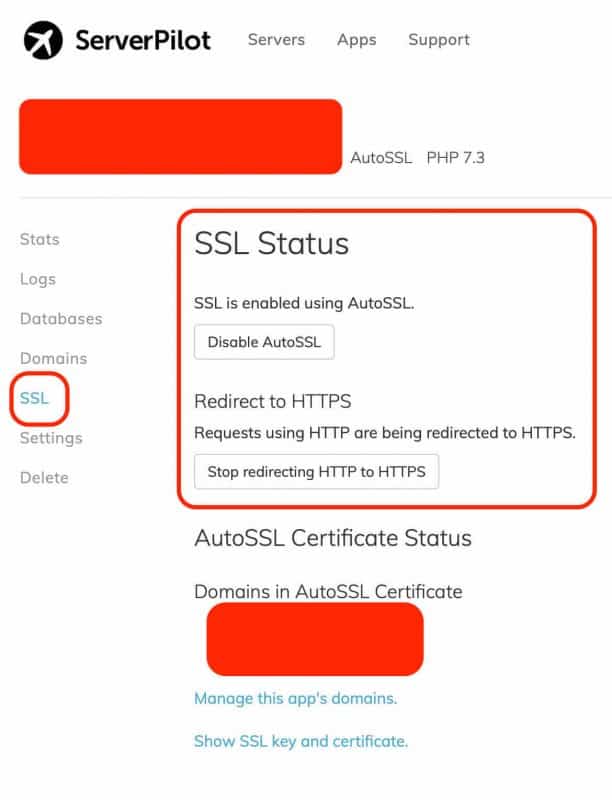
Here, you will be able to enable the “Auto SSL” and “Redirect to HTTPS” options once your DNS has propagated and your server will be ready to be used.
Sign up for a Serverpilot account here.
There’s just 1 thing left to do.
Uploading your landers through FTP/SSH with Cyberduck
Finally!
It’s time to upload your landing pages and start sending traffic! Download Cyberduck or use any other FTP client if you have a personal preference and open a new connection like the image below:
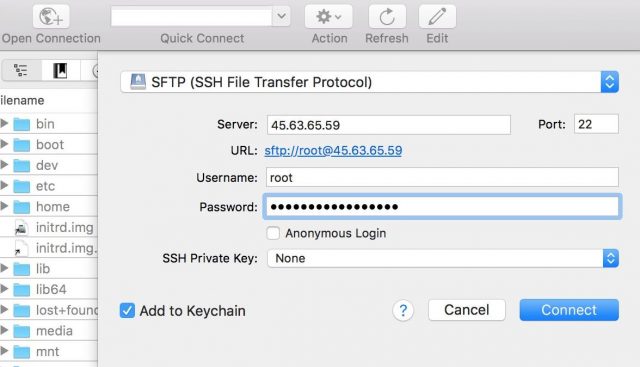
Make sure you set up an SSH connection (secure FTP) which will open the port 22 and write down the IP of your VPS in the server field. Also, write the username (root) and password (you can check them in your Vultr’s VPS dashboard again) and click connect.
Most probably you will be directed to an empty folder after this, as everything has been moved to a new location inside Serverpilot’s files.
Now go to the following address: srv/users/yourserver/apps/yourapp/public
You need to replace yourserver by the name of your server on Serverpilot and yourapp by the name of your app as well. Or simply click through the folders and you will find the desired path as shown below:
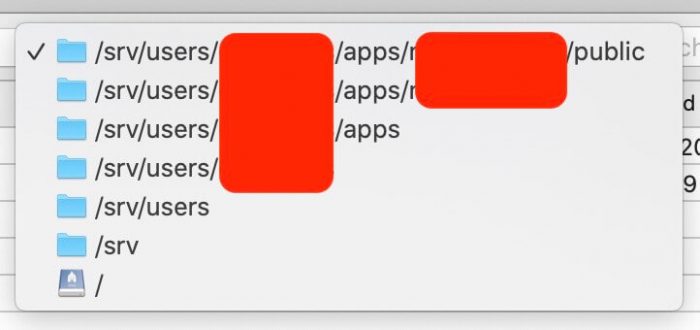
Now it’s time to upload your landing pages. You can upload any file by dragging and dropping it from your computer to Cyberduck and name it as you please.
I recommend your to create folders and organize them so you can have as many landing pages as you want in your domain instead of just 1 landing page on the home page.
You can host hundreds or even thousands of landers in just 1 VPS if you use folders and organize them as long as you have enough space in your disk.
Additionally, don’t forget to keep an eye on your CPU usage and bandwidth stats.
This will tell you if your server is capable of handling the volume of traffic you’re sending in real-time and you can also keep an eye on the bandwidth you’re using to see if you’ll need a higher plan. You can do this by upgrading your Serverpilot’s plan to check CPU, memory and disk usage, or if you want to save some money you can check your stats in your Vultr’s dashboard (albeit it won’t show your RAM memory stats).
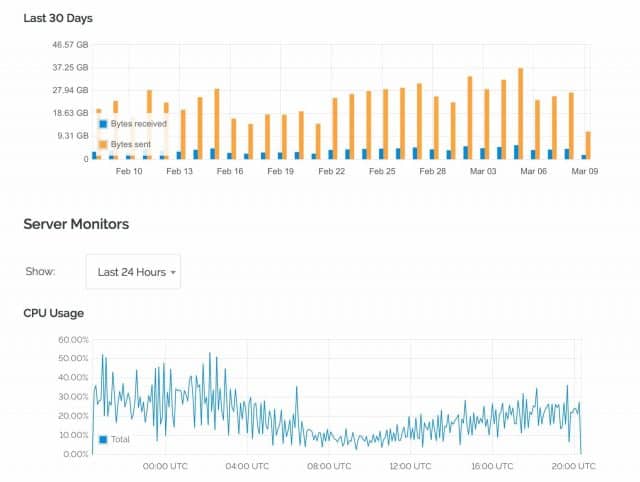
In the image above, you can see a $10 per month server receiving 1 million visits per day with a very light (20Kb) landing page. So far the CPU usage goes up to 40-60%, and the bandwidth consumed is around 600GB from 2,000GB (2TB) available, so it’s running fine.
Of course, I like to distribute my traffic between several servers in different locations and different plans according to the volume, but you can easily upgrade your plans as I explained at the beginning of the article.
This setup generally works better than using a CDN (if the geo is close to your server) and definitely beats a VPS/dedicated server in the USA from managed hosting companies when you’re running campaigns around the globe.
The only times where I’ve seen a CDN outperforms this set up is when I buy traffic from places like South Africa or some parts of Asia where there are no servers around.
The best part is you’re only paying $6 (Vultr) + $5.5 (Serverpilot) to get a super-fast server for a total of $11 and you can scale it up as you go instead of signing up for a monthly contract and paying $150 for the same performance on a managed dedicated server.
Now go and create your first VPS + SSL and start running some traffic and enjoying your extra ROI 🙂
Hello Servando, I am trying to decide on whether to go with an unmanaged VPS or AWS S3+CDN. What type of maintenance or updates have you had to perform to keep your server performing? How do you know when to update software etc and how much time do you spend on server maintenance….?
I have no experience maintaining servers and I want to be able to upload landers without having to hire IT personnel for ongoing maintenance or troubleshooting.
Hello William.
I don’t need to do any maintenance to my servers. The only thing I’ve done perhaps once in a year (if my domains or landing pages last that much), is to update the PHP version of my server, which takes 30 seconds and is a 1 click button from Serverpilot.
Other than that, no time needed.
Hello servando, can I link a domain to multiple servers to improve speed from different geos.
Just 1 domain to multiple servers? I don’t think so unless you use an additional solution such as a load balancer or CDN.
You can have many domains and route them to different servers though.
Awesome content, I was wondering if I can migrate my landing page to a VPS if it has been made with drag and drop website builder called Unbounce considering that the landing page is only available in an Unbounce file and not an HTML file?
thanks:)
I don’t think you can do that unless you transform it to HTML completely.
Hola Servando. Muchisimas gracias por el tutorial es increible, he aprendido mucho. tengo una duda. si quisiera tener unas landing pages y tambien un sitio web en wordpress en un mismo servidor vultr de $5 se puede? o tendria que crear otro servidor de $5 solo para wordpress? muchas gracias
Hola Andrés. Si se puede si usas algún manager como Serverpilot. Puedes agregar los dominios que quieras hasta llenar la capacidad del SSD de tu servidor.
Vultr promo is only for 1 month. The bonus is applied to your account, but removed after 1 month.
Yeah. The bonus expires a month after enabling your account so better use it as fast as possible 🙂
Hi Servando,
Thanks for your tutorial. But there is one thing I have a problem when setting a custom domain from namecheap for redtrack tracker. As you choose “Custom DNS” on namecheap and under Advanced DNS, it didn’t show “CNAME” if still I want to change it.. I need to choose Default “Namecheap basicDNS”.. hmm so confuse.
Do I need to put http://track.mylanding.com??
and ignore the other setting. I think the setup similar to voluum.
Will it affect the tracking?
If you choose a custom DNS on Namecheap you need to manage everything under that custom DNS now. In this article, we used Vultr for that.
I don’t use Redtrack so I don’t know how it works, but you should ask their support instead.
Hi Servando,
You mean I can point my CNAME of Redtrack under VULTR? Without Namecheap? Will it affect the tracking capabilities?
And another one you talk about DNSMADEEASY. If you have more free time could you please show us a tutorial on that..
What’s Taking place i’m new to this, I stumbled upon this I
have discovered It absolutely helpful and it
has helped me out loads. I’m hoping to contribute & help other customers
like its helped me. Good job.
Vultr was a nightmare for me! hardly any support and the IPs always banned i went to https://www.weelinks.info/u/digitaloceanhosting/ DO instead they have been *touch wood* pretty good so far.
DigitalOcean and Linode are good alternatives.
I have had droplets disappear from DO though, and their hardware is the slowest if the 3 providers, but still good for the price.
Hello Servando!
As a newbie, I’m wondering how significant a problem this original comment points to about IP addresses.
I am planning to follow your tutorial, but if IP addresses are frequently blacklisted with Vultr….how major an issue is that?
Are you actually suggesting Digital Ocean or Linode instead or only on rare occasions?
Can’t wrap my head around how big a concern this is…..or not.
Can you possibly quantify the issue a bit and put it into perspective? How worried should a new aff be?
Big issue?
Little issue?
How to confirm IP’s are good?
Workaround if encountered?
Thanks so much!
Mark
Not an issue for a newbie and it hasn’t happened to me this whole year while running campaigns.
There are many other factors way more important than IP flagging.
Thank you!!!
Hola Servando.
El artículo es fantástico, enhorabuena.
Quería preguntarte si recomendarías Vultr + Serverpilot en proyectos de WordPress que monetizan por Adsense o por Amazon Afiliados.
Actualmente, los tengo en un servidor con la ip igual para todos, y creo que sería mejor dividirlos por ip de diferentes países.
Muchas gracias.
Un saludo.
Antonio.
Hola Antonio.
Si, funcionan muy bien para WP. Mucho más rápidos y a un precio mucho más accesible que en muchos otros hosts que te cobran por ancho de banda, número de visitas, etc.
OMG, this was the easiest server set I have ever done. Yesterday I tried doing a server set up I got from another source and it never worked. 3 1/2 hours wasted. I read through your post then set up my server. It took me 20 mins to set up if not less. Thank you. I shall give you my email so that you can send me more tips and tricks.
Lastly, how do I go about setting up Cloudflare?
Good to know it worked for you!
Adding Cloudflare is simple. Just create your account, add a domain, and follow the steps. It takes 3 minutes as you just need to point your DNS to Cloudflare’s name servers and that’s it.
Hi Silva,
Your Content is amazing…
I use the same setup since year now but in addition, I use Cloudflare free CDN.
SSL from ServerPilot, Cloudflare only to make content loads from CDN servers because I use the same server for All Geos…
I heard that Cloudfare is a bad idea when running with pop traffic cause their firewall can block a portion from the pop traffic, do you agree?
By the way, you theme is Amazing, Can you please tell me your WordPress theme
I want to open an Affiliate blog in Arabic to share my experiences in CPA marketing.
Respect Bro ♥
Thanks, man.
Yes, I agree and I don’t use Cloudflare for anything related to my landers or tracker. Even more with pop traffic.
I disable the orange cloud with them and just use them as a DNS service.
As for my theme, you can get it at StudioPress.
Cheers!
got it all setup thanks man now im just waiting for dns to go through and then hopefully upload some landers and get traffic thanks>>
Glad it worked for you 🙂
sir i all setup vultr serverpilot and domain and upload blank file and one landing page where i found this as u ref srv/users/serverpilot/apps/yourappsname/public
and where i found my files bcz site is not running guide?
You need to open cyberduck or filezille and connect to your server as shown in the images to go to that file directory.
this post is 3 years old (though updated sometimes) but still is a gem!
Thanks man.
Your affiliate links deserve to be used 🙂
Kudos!
Thanks, man.
I literally updated the post with a ton more info just a couple of months ago so it’s still very useful.
I have just started my journey in CPA field.
do we have to use the vps from the beginning, as i see, many are using W*x to create landing pages or wordpress in shared hosting,
of course, in the beginning, i dont expect 50K to 100K traffic . , as it may grow gradually depending on the traffic network we use.
my question is, can we use the shared hosting first or is it necessary to go for the unmanaged vps. thank you and your guide on the vps is way too good. keep it up.
Hi Manoj.
If you spy affiliates running CPA offers you won’t find those wix/wordpress landing pages. That’s more common for bloggers but not for CPA as performance is everything.
Also, starting with a VPS (unmanaged) costs as much as $5 per month, which is almost the same as any cheap shared hosting with super slow speeds.
What type of traffic are you going to learn?
Is it good idea if I want to run native to use Amazon S3 or rather go with Vultr?
Both are good.
Vultr has a much simpler and easy to use interface.
Amazon service can be super hard and confusing for new people.
Work great!
Since Zeropark no longer accept non-https, I figured out how to install SSL on Vultr. Hope it helps someone in here.
https://www.vultr.com/docs/setup-letsencrypt-on-linux
Yeah. I recommend having SSL in all of your landers no matter which traffic source you use.
I’ll update this guide soon.
Hi Servando, any hope you will post update for ssl in vultr ? Tx
I’ll definitely do it in September!
Can you do a training on how to use Vultr with Serverpilot
Hi Douglas.
I swear I’ll do it this month. I’ve just been swamped with a ton of stuff.
Do i have to buy domain for every server?
Do you have a guide on how to add subdomains?
Yes, you need a domain for every server.
You can add subdomains or multiple domains to each server as well. It’s an easy process with serverpilot.
Thank you so much… WOW, you Awesome 🙂
Thank you for compiling this awesome blog post and yes I do think that Vultr is an awesome hosting provider. However, I was wondering if the process remains the same with the managed Vultr hosting which is powered by Cloudways. Below, you can find the link to their managed hosting provider: cloudways.com/en/vultr-hosting.php
I haven’t tried Cloudways although I’ve heard good things about them. I prefer to manage my servers with Serverpilot.
Hi,
I created a new server but I tried to access root files using cyberduck ssh protocol but cant find the root files (0 files) I am trying to browse the logo.png and index.php default files but cant find them
i also dont know how to navigate to usr/share/nginx/html through cyberduck , sorry for the silly question but their is something wrong
hi Servando, really nice guide. But I have couple of questions, just wanted to understand the difference with my current setup.
As you, I am only using simple static landing pages (html, css, js) but host them on Amazon S3.
Do you think, it’s better to go with your own VPS rather than Amazon S3? What are the cons of Amazon S3 for affiliates?
Another question regarding Cloudflare, do you think it makes sense to connect it to Vultr in your setup (to get a free SSL + CDN of course)? Considering that traffic is only US based.
And the last question is about SSL, is there any difference between cloudflare shared SSL, your own SSL via e.g. comodo or Serverpilot’s SSL?
Amazon S3 can be a little expensive in my opinion but sometimes it works better.
The easiest way is to setup a split test and decide for yourself for the geos you’re buying traffic from.
As for Cloudflare, I don’t really use it as I prefer having the SSL installed in my server than through the DNS. Cloudflare’s SSL isn’t really safe and I feel it’s slower most of the times.
Hi Servando, you mentioned that you use Serverpilot to connect with Vultr to enable SSL, do you setup the Vultr server as Lemp Ubuntu 16.04 x64 or CentOS when you use serverpilot.
I am asking because Serverpilot says “Your server must be Ubuntu 16.04 or 18.04 (64-bit).
Only clean servers (no Nginx, Apache, or MySQL installed) can be connected to ServerPilot. ”
Many thanks
Ian Hagerty
Hello Ian.
No, when using Serverpilot I launch a VPS with Ubuntu 18.04 alone without any stacks.
Serverpilot will take care of the rest.
Please, when I launch a VPS with Ubuntu 18.04 alone I don’t see nginx… where will i now upload my html file. Thank you
If you launch it alone with Ubuntu 18.04 there is no NGINX until you connect it with serverpilot and let it install everything.
After that, the URL you need to access your files is: srv/users/serverpilot/apps/yourappsname/public
Thank you so much… this worked perfectly for me 🙂
Please, can you also help me? How can I upload multiple sites with a different domain on the thesame server
Glad to help!
If you want to add more domains you need to:
1. point them to your server IP as you did with your first domain
2. go to serverpilot and create a new app in your server with that domain name
3. done!
You can use the same directory to access your files but when you get to the apps folder (srv/users/serverpilot/apps/) you will now see a new folder with the new app name you’ve just added.
One of the best cloud network in the world ! thanks for the article
Awesome guide Servando, thankyou very much indeed, I would never have been able to do this without your guide.
Glad to help 🙂
Hi,
Do you use SSL for your landing pages? If not, why you think it is not worth it?
Thanks.
Yes I use it.
For SSL I connect my vultr account with Serverpilot.
When I went to create an account and Lemp have different versions. what do I choose because the portal have somehow change from your screenshot?
You can choose CentOS 7 to have the same setup as this tutorial.
Hi silva,
great post. i have one problem, i didn´t find the path: usr/share/nginx/html. i find only “usr/share”
any alternative?
apreciate your answer
Unless you did something different it should be there.
Try reinstalling the VPS and see if it works.
i checked every step once again, everthing seems to be fine.
i think maybe bacause the DNS settings still not have been propagated, as you said it takes up to 48 hours.
Thank you for the guide. I am curious. I don’t have much money now for cloud hosting on Hostgator. My question is can I use Vultr $10 monthly to host a 100,000 website ? Or is 50,000 traffic too little?
Vultr should be able to handle 100,000 visits per day without problems even with the $5/month plan. If you have 50,000 or 100,000 visits per month any shared hosting could handle that easy.
Don’t use Hostgator, they suck.
Hi Thanks for great content.What if i want to create multiple landing page for one offer to test them.
Would you recommend to use all lander in same server and test in campaigns or you will buy $5 server for each lander ?
or upload all like lander1.html
lander2html
lander3html or with folder wise like http://www.example.com/lander1/lander.html
Thanks great content
You can use the same server for the landers and upload thousands without paying extra.
You can either put them in folder or just with different names as you mentioned in your example.
Thanks.Great contents.That’s what i was looking for.Now i bookmarked your blog for more information.
Thanks Servando, my Landers are up and running thanks to your Post. Thanks fOR Sharing . ALL THE BEST!
Great to hear! Mark.
Hey man, this is a great blog and I’m glad I found out about you from STM! Please keep the great content coming. I’m having a problem with the setup. I’ve followed all of the steps until the ” uploading a lander” part. I opened the root files, opened the following files >> (usr/share/nginx/html), and I deleted the files that said index.php & logo.png. But after I upload a new file (using Cyberduck) and enter my domain name It says 403 Forbidden nginx/1.14.2 I even tried typing the domain name/offers/the file name. and I still get an error message. Any idea what the problem might be?
Hi. If you’re trying to access directly through your domain name you need to name your html landing page “index.html”.
Otherwise you just need to input your domainname.com/filename.html
Hi
Great post I will try Vultr but I have the landing pages as html copied and pasted in a text file and the other in word document how to upload to Vultr in this format should I use lemp or other
Text file and Word document?
Why? Just save them as .html and will be good to go.
Thnx but the html was sent to me in a word document so how can I change it to html and upload to Vultr sorry for many questions
Google search that. It’s a very simple process that takes 30 seconds to do.
There’s literally hundreds of free tutorials explaining that already.
I’ve gone the rat hole of all your content including youtube interviews. Awesome content man!
Quick question: I just got a server with vultr and I was wondering if you have any resources on how to add SSL to our servers?
Keep up the great work & thanks for the motivation.
Rammy
I use Serverpilot for the landing pages in Vultr to add SSL for just $5 per month.
Hola Servando,
He comprado la instancia de 5$, y las landing pages me cargan en torno a los 0,5 segundos.
Creo que es un buen tiempo, pero si le añado el tracker (bemob), le mete 1 segundo más. ¿Crees que es demasiado?
Gracias.
Hola Manuel. Cuanto pesa tu landing? Se me hace bastante el tiempo de carga. Además como y desde donde lo estás midiendo?
Pesa unos 150kb.
Lo estoy midiendo con esta web http://www.webpagetest.org
Con el link directo de mi dominio, me da 0.5 segundos desde un servidor de España (mi vps está en Alemania).
Si lo pruebo con el tracker adsbridge, le mete 0.3 segundos más, y con bemob, 1 segundo.
No he escuchado muchas cosas buenas de bemob pero 1 segundo es bastante. Lo único que sé es que tiene un precio muy accesible.
Depend del tipo de tráfico que compres la diferencia podría ser poca o mucha. Si es pop, 1 sgeundo extra es demasiado, pero si es clickeado de banners, sobre todo en desktop no habrá mucha diferencia probablemente.
He estado haciendo más pruebas, y no es problema de vultr, es el tracker, que le mete entre 0,8 y 1 segundo más de tiempo de carga.
Supongo que al final el dinero que te ahorras en voluum, lo pierdes en tráfico con estos trackers baratos.
En general, para tráfico pop en móviles (que es en lo que me quiero iniciar), si el tiempo de carga total (con tracker incluído) es de 1 segundo o menos, crees que es un buen tiempo de carga?
Gracias.
Claro, lo barato muchas veces termina saliendo más caro.
El tráfico pop, y sobre todo par amóvil (y más si es de carrier) es el que necesita cargar más rápido que todos. Yo sí invertiría en esa diferencia.
This is one of the best most detailed posts I have ever seen on LPs for affiliate marketers, thanks so much!!
My question is this.. I want to run traffic in N Africa and Middle East. There is no server directly in those geos. Do you think the one in Germany will be close enough to supply LPs at the awesome speeds you are talking about? Much appreciated 🙂
I think Paris would be the closest to Africa and Frankfurt if you’re running offers to countries like SA, UAE, etc.
Glad you liked the guide.
Ah yes, you are correct! So just load it up @ Paris and use a tool like pingdom and see how fast it loads from a nearby server I assume? Thx
Yeah. It’s difficult to find servers for that area but they perform well from Europe.
If we chose to use cpvlab, is it necessary to have separate server for it or is it ok to use 1 server for both landing page & cpvlab in vultr
Whatever tracker you use, always separate your landers from your tracker with different servers and different domains.
Better be safe than sorry.
Can I just use cloud based tracker like bemob and just link a domain to the tracker.?
That’s for the tracker, yes.
But you should have another domain linked to your landing pages.
I understand do separate tracking domain and LP domain. But what’s the point in separating server?
Fewer points of failure since you don’t have everything on the same computer.
Plus, if you use a cloud-hosted tracker you don’t have access to that server for landing pages anyway.
hy servando need help here, i dont really know what happened but i just uploaded my lander to my VPS hosting but i cant see any image only text files, what should i do ? do you think its because of the file extension as .html ? because all i see is text and no image of css styling i did, please am looking for to your reply.
Did you upload your images/CSS and changed the URLs to point to those addresses instead of pointinng to your computer files?
thanks its been all sorted out
guys please i need your help here i think i have run into some issues with VULTR, after deploying the new instance i haven’t gotten any email with my details, what should i do? how long does it really take to receive that email?
It takes 2-5 minutes at most.
Was your instance created or not? You can see it in the dashboard.
honestly it wasn’t created at all even after clicking the deploy now button, well i emailed them and i was told that my account is fine and i should a new instance, i will try that again and see what happens. thanks servando
just deployed a new server now and its working like magic thanks so much servando i guess they rectified the problem
Good to know 🙂
Now just follow the steps and you’ll be sending traffic in no time.
hi servando, quick question regarding loading speed and landers, before i got to know about VULTR which i learnt from you, in the previous times i create landing pages using ELEMENTOR in wordpress, but since am not a coder i dont how to code landing pages, do you thinks its advisable for me to copy my lander using HTTRACK and upload it to my server at VULTR? will the loading speed decrease because i initially used wordpress with the ELEMENTOR plugin?
Yeah, you can start using an ad spy tool like Adplexity and modify your landers from the ones you download until you start learning more.
Don’t use WordPress for a lander. Unless it’s clicked traffic it will be super slow vs a clean lander. Which traffic source are you learning?
am learning with airpush
That means you’re targeting mobile traffic and you want your lander to load as fast as possible unless you’re sending them to a news site or blog to consume content.
when you said “Select a location closer to where you’re going to run your campaign” do you mean i should select a server located in Australia if am running an offer in AUSTRALIA?
Exactly 🙂
Select the closest one to your geo at least. Like maybe you’re going to run a campaign in Italy but Italy is not available as a VPS location, so select something like France or Germany instead of USA.
thanks alot man your the best. do you have any idea how i could create landing pages in another language asides english ? because some of the times i see good looking offers in GEOs in different languages.
You can hire translations services like 1hourtranslation or simply from people from upwork,fiverr, etc.
Nice post here i really learned a lot, i almost made asuper mistake of launching my campaign using shared hosting, thanks again. But i have a question can i run traffic from different GEOS to my landing page that i uploaded to vultr??
Yes, you can. If the geos are very far away the you’re better with multiple VPSes but for testing purposes it’s fine.
Hola servando gracias por tu tutorial. tengo una consulta, estoy probando los servicios de google cloud, aprovechando la prueba gratuita de $300, he instalado manualmente LEMP, Centos 7+Maridb+Nginx+PHP, eso en una instancia que usare wordpress,y otra instancia que será para mis landingpage estáticas, sin MariaDB. Que me podrías decir acerca de google a compracion de otros servicios que tu recomiendas cómo Vultr. Gracias por tu respuesta.
Google Cloud es el único servicio de los grandes que me falta por probar. Así que no hay mucho que te pueda decir. Normalmente subo todo a Vultr o AWS después de haber probado todos los demás.
Saludos.
hola servando cuando subo mi landing page a la carpeta html si la puedo ver, pero si por ejemplo intento usarla creando carpetas para tenerlas mejor organizadas tal cual como explica en la pagina me aparece 404 not found cuando voy a la url.
Tienes alguna idea de porque me esta sucediendo esto? las landing estan echas en purelander y el cliente ftp es cyberdunk
Estás poniendo esas carpetas dentro de la carpeta “html” como en el ejemplo que puse en el artículo?
Hi Servando,
Very good tutorial here. I am using vultr to have a wordpress site running but I dont find good tutorials for install the ssl, do you have any? If it is in spanish, better.
Thanks.
Look for the tutorials in Digital Ocean. The process is very similar.
Otherwise if console and code is too much for you I recommend you to use Serverpilot. This helps you manage your WordPress site, database and SSL much easier.
Hey Servando,
How to add a new sub-domain to your Vultr server?
Have you ever done it before?
I don’t use subdomains with Vultr, but there are a lot of tutorials to do it if you Google search them. If you don’t find any for Vultr, try looking for DigitalOcean or Linode, which is pretty much the same in terms of how it works.
Thanks servando for the amazing article , i really need this .
okay good we are done with the Landing page part .
what about the tracking tool ? .
if i hosted my tracking tool in unmanaged Server it will work great but if i run traffic from different GEOS that will be the problem .
should i go with cloud hosting tracking tools ?
if yes then what do you recommend ? .
i already have CPVLAB .
what solution are you using in person ? .
Yes, for traffic in different geos you can have a new tracker install or simply go cloud hosted.
For several trackers in your servers I’d try Thrive or FunnelFlux, and for cloud hosted I’d choose Voluum or Adsbridge.
Hi Servando, first off thanks for this guide; very easy to follow.
I have an offer that I’d like to test that accepts leads from 3 different GEOs around the world. I set up one server and its working well but I want to test those other 2 GEOs. So in your opinion, should I buy 2 new domains just for those GEOs and create 2 more servers, or set up a CDN?
Hi Christian. The servers should perform better but initially if you want to save some money you can either use the CDN (you will need to use some domains there too) or just test it from your current server and if you see conversions or any potential then quickly deploy new servers in the proper locations.
Gracias por responder
Estos son las imagenes: http://bit.ly/2qe1nkN y http://bit.ly/2riS7M7
Parece que lo estás haciendo con otro programa y no tienes el directorio ni folders creados aún.
Lo puedes hacer con el mismo procedimiento que muestro aquí y ver si te funciona?
Hola Servando.
Muchas gracias por el tutorial. Tengo un problema al intentar subir la landing. Me sale este mensaje de error: 404 Not Found nginx/1.12.0
Cuando intento subir la landing, Filezilla tambien me da un mensaje de error: usr/share/nginx/html: no such file or directory
No se que estpy haciendo mal, he revisado los artículos de ayuda de Vultr pero no hay nada sobre esto. Agradecería una ayuda.
Hola Yuli.
Crees que puedas subir una captura de pantalla del error y en que parte lo estás viendo exactamente del directorio?
Saludos.
Hello, Servando
Thank you for your awesome tutorial. I have gone through your tutorial and uploaded my first landing page in VPS hosting. I got few error it says (Some files on the server may be missing or incorrect. Clear browser cache and try again.) All the images are missing but only text are live. Would you mind helping in this issues?
Which company are you using and where did you get your landing page?
Thanks for you replay. I love to go with you recommend tools and resources. I am using Adobe Muse to design my landing page. I designed my landing page, saved as html and then uploaded through FileZilla. I have uploaded my landing page in Vultr with the help of this tutorial and my site gone live. Also today I am testing Purelander to make landing page. I have made few from purelander and uploaded to vultr but also same thing happen. I got no Images and design. Its only showing simple text not images, design and saying Some files on the server may be missing or incorrect. Please have a look of this img.
Image= https://goo.gl/PRvrIA
if you’re crafting your landers as local files in your PC and then uploading them to the server you need to update the URLs in your index so they load now from the server (the server can’t load them from your computer now).
That’s something simple you should fix with a couple of Google searches 🙂
Thanks for your time and effort. Still I am confusing and unable to solve the issue. This is my first time in unmanned VPS hosting and I am trying to get solution on every field but somehow i lost. Would you mind referring me any guide? Sorry Sir…i know its sound annoying.
Hello,
Thanks I got it. I made it. Once again thank you very much for your this tutorial. 🙂
Good to know it’s solved 🙂
Hi Servando,
Thanks for your precious how-to.
I have already deployed a Vultr server (VC2) for Funnel Flux tracker.
Now, I would like to deploy a new server for my LPs, but I do not well understood if a service such as http://www.vultr.com/pricing/ is comparable to http://www.cdn77.com/pricing or http://www.rackspace.com/en-gb/cloud/cdn-content-delivery-network.
Are they comparable?
You’re comparing a VPS vs a CDN.
They’re different things. For example, on the CDN you wouldn’t be able to deploy FunnelFlux. CDNs help deploy static content so for landing pages are OK (although I explained the performance between a CDN and a good VPS in the article) as long as they don’t use PHP.
I think the second most important thing regarding to LP speed (beside optimisations), if not the most important is actually how fast tracker is redirecting to LP cdn url.
Not sure how many data centers do voluum and adsbridge have for example.
But if theirs redirection like 500ms in some countries, than any VPS can’t help 🙂
Sure.
Voluum runs on AWS. Not sure about Adsbridge. Which tracker do you recommend in case you’re running traffic from one of those tier 3 geos where there’s no CDN/AWS nodes available close by?
Not sure, I am just sharing my thoughts 🙂
I suppose voluum, but that needs to be hard tested.
I doesn’t mean AWS will work super fast, as we would like it to run.
I like to run landing pages with 50ms max.
I even know company which made it’s own custom tracking solution
for internal purpose, with IP databases etc.
And they have huge competitive advantage already, because they can control the whole process and achieve maximum speed, for example skiping one extra DNS resolve step..tracker can launch LP, no need for redirect etc.
I thing there is much area for improvement in affiliate tech sphere 🙂
Best
Yeah, AWS won’t perform as well in many regions. I’ve tested it many times.
As for the competitive advantages you mentioned, Thrive has them so if you’re looking for max speed they could be an option.
How I can add subdomain with this server?
Google it. There are tutorials, especially if you look at the DigitalOcean database.
Great option to host my LP
and what about my tracker example CPV Lab that requires your own server, can i hoted in the same Vultr Account?
Cheers
Yes, you can do that too but I don’t recommend you use an unmanaged host like Vultr for a tracker if you don’t know what you’re doing.
The only tracker I’d recommend for this is FunneFlux as their installation is completely optimized for Vultr.
Great Man!
but I need to know How to enable gzip compression on this server?
Hope this helps: https://www.digitalocean.com/community/tutorials/how-to-add-the-gzip-module-to-nginx-on-centos-7
Have you run speed test services to prove this?
I have tested several times Amazon or Vultr versus my dedicated/VPS in the US with tools like gtmetrix or pingdom and the results are always very very similar. The loading times do change when testing from exotic locations like Asia or something, but for US and EU they are similar.
It would be nice of you included some tests yourself. In my opinion, just my opinion, the hassle of setting up unmanaged servers is not worth it.
Yes. I’ve tested this many times and with huge volume of traffic.
Just to be clear, when I mentioned Amazon I’m talking about their Amazon lightsail service, which is a straight competitor of DigitalOcean with similar prices. If you’re talking about Amazon AWS overall it’s probably more difficult to setup initially than a server with DO.
You’re right about the US though. I find bigger differences in other parts of the world like Asia, Latin America and others. For US they all perform really well.
There’s not much to setup or maintain with an unmanaged server if all you do is slap a few landers and you create new instances a lot.
This mean the server NOT recommend for Asia traffic or what you advice when I run campaign in Asia?
No, this means I actually recommend this setup for Asia. They have nodes in Japan and Singapore, so if your geos are near those countries the setup should be quite fast.
Did you test digitalocean with new loadbalancer feature?
https://www.digitalocean.com/products/load-balancer/
It seems as a good solution, like having CDN advantage with VPS speed
Hi Goran.
It’s something they launched last month. I haven’t tested it yet although DigitalOcean always gave me lower results than Vultr and Linode.